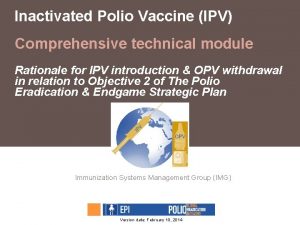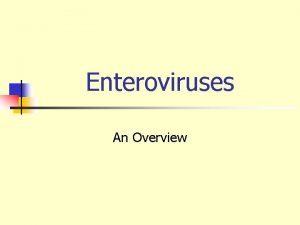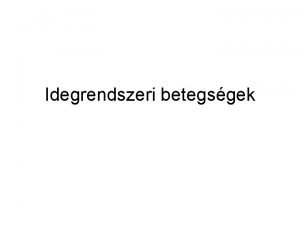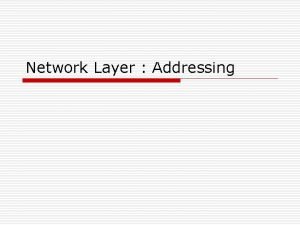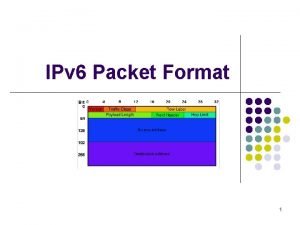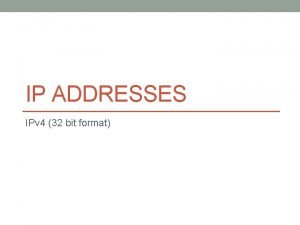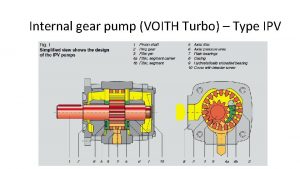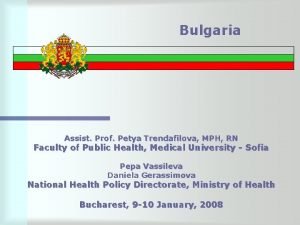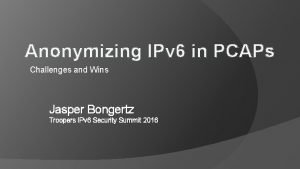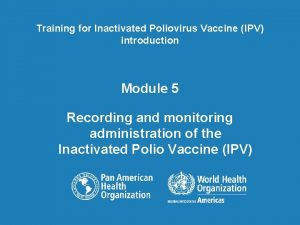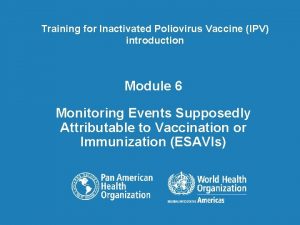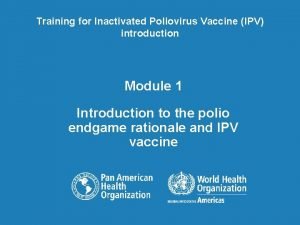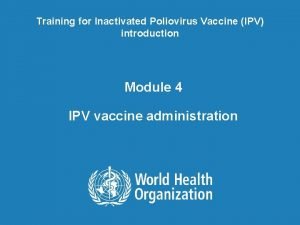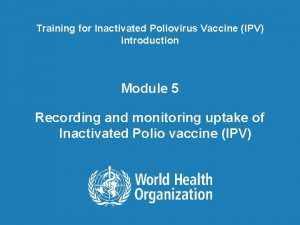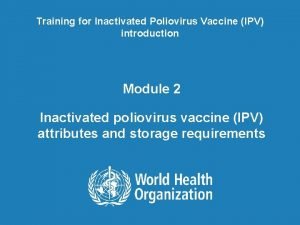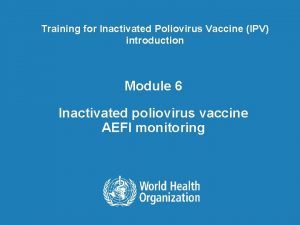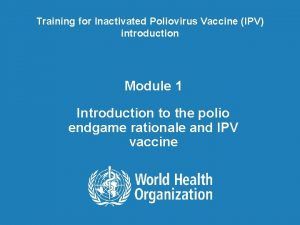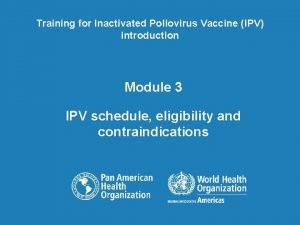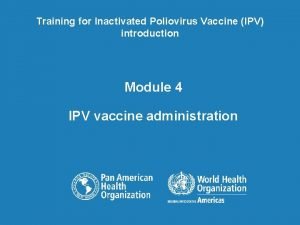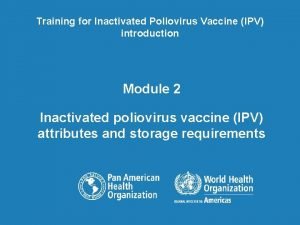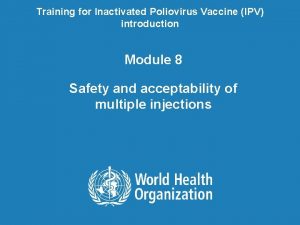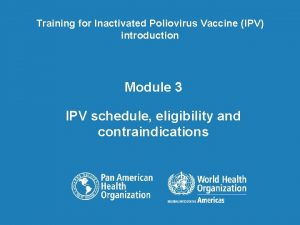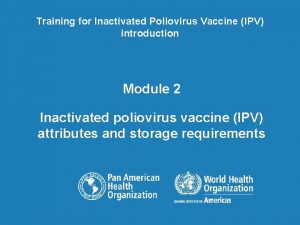Training for Inactivated Poliovirus Vaccine IPV introduction Module

















- Slides: 17

Training for Inactivated Poliovirus Vaccine (IPV) introduction Module 1 Introduction to the polio endgame rationale and IPV vaccine

Learning objectives l At the end of the module, the participant will be able to: – Understand poliovirus transmission, poliomyelitis disease and global progress toward polio eradication – Recognize the vaccines available against polio and the risks and benefits of each – Describe the rationale for introducing IPV into the routine immunization schedule l Duration – 25 minutes 2| Introduction to polio endgame rationale and IPV, Module 1 | February 2015

Key issues 3| Introduction to polio endgame rationale and IPV, Module 1 | February 2015

What is polio disease? l Polio (also called Poliomyelitis) is a highly infectious disease caused by a virus l The virus invades the nervous system and can cause permanent paralysis l Polio is spread through person-to-person contact and can spread rapidly through a community l Most infected people (72%) have no symptoms l However, one in 200 infections leads to permanent paralysis (can’t move parts of the body) and even death 4| Introduction to polio endgame rationale and IPV, Module 1 | February 2015 www. immune. org. nz

How does poliovirus spread? l Poliovirus infection is highly contagious l Poliovirus is spread mostly by the fecal-oral route – Primary mode of transmission – passage of the virus in stool to the mouth of another child – Can also be spread through saliva or droplets from a sneeze or cough Child excretes virus in stool and does not wash hands after using the bathroom 5| Virus transferred to objects from hands Virus transferred to another child’s hands Introduction to polio endgame rationale and IPV, Module 1 | February 2015 Virus transferred ingested Next cycle of infection

Advances in Polio Eradication 2013 -2014 1988 • • • 350, 000 cases • 416 cases reported in 2013 125 endemic countries • 359 cases reported in 2014 World Health Assembly resolved to eradicate polio • 3 endemic countries • 2013 -2014: 7 countries with re-established transmission 6| Introduction to polio endgame rationale and IPV, Module 1 | February 2015

Types of polioviruses l 3 Types of polioviruses – Wild poliovirus (WPV) – 3 serotypes • Type 1 – 359 cases in 2014 this is the only type of WPV in circulation today) • Type 2 – eliminated in 1999 • Type 3 – last case reported in Nov. 2012 (more time is needed to certify eradication) 7| Introduction to polio endgame rationale and IPV, Module 1 | February 2015

Types of Oral Polio Vaccines l 3 Types of Oral Polio vaccine – Trivalent OPV (t. OPV): types 1, 2 and 3 • most commonly used OPV in routine immunization globally – Bivalent OPV (b. OPV): types 1 and 3 • commonly used in supplementary immunization activities (SIAs) – Monovalent OPV (m. OPV): type 1, 2 or 3 • primarily used for SIAs in areas where only type 1 or type 3 is circulating OPV is still the primary vaccine for eradication 8| Introduction to polio endgame rationale and IPV, Module 1 | February 2015

Paralysis associated with OPV l OPV offers effective protection against polio, but. . . in very rare cases it can lead to paralysis l Vaccine Associated Paralytic Polio (VAPP) – Vaccine virus spontaneously changes and becomes capable of causing disease Globally • 1 case per 2. 4 million doses administered; (250 -500 cases/year) • 40% of VAPP are from type 2 OPV Region of the Americas: • One case of VAPP per 7. 68 million doses administered • 24% of VAPP cases are caused by the type 2 virus (28%- by type 1, and 31%-type 3) l Circulating Vaccine Derived Poliovirus (c. VDPV) – Rare outbreaks caused by person-to-person spread of vaccine strain, which mutates/changes to a highly transmissible form capable of causing disease to the nervous system, in areas/countries with low coverage – Low coverage is the main factor for the occurrence of c. VDPVs – 97% of c. VDPVs are from type 2 OPV in recent years 9| Introduction to polio endgame rationale and IPV, Module 1 | February 2015

WPV and vaccine-related polio cases 2009 -2014* Through the use of OPV, polio cases related to the wild poliovirus have decreased. Today the number of polio cases due to OPV is greater than those related to the wild virus. 10 | Introduction to polio endgame rationale and IPV, Module 1 | February 2015 359 Post-interruption of WPV transmission

Polio eradication plan l In May 2012 the World Health Assembly of WHO declared poliovirus eradication to be a global public health emergency l Under this plan to achieve a polio-free world, they recommend that the use of OPV must eventually be stopped worldwide l OPV will be withdrawn in 2 phases beginning with type 2 OPV l Type 2 OPV has the two risks: VAPP and c. VDPV – and is no longer needed for eradication – hence the type 2 containing OPV will be eventually withdrawn from use globally. 11 | Introduction to polio endgame rationale and IPV, Module 1 | February 2015

Polio eradication plan (continued) l WHO’s Strategic Advisory Group of Experts (SAGE) recommends that all countries introduce at least one dose of IPV into their routine immunization schedule by the end of 2015, before type 2 OPV is withdrawn l Rationale for this includes: • Contribute to the final phase of polio eradication • To reduce risks associated with type 2 OPV withdrawal • Maintain immunity against polio type 2 during the global withdrawal 12 | Introduction to polio endgame rationale and IPV, Module 1 | February 2015

Comparison of OPV and IPV? Oral polio vaccine (OPV) • Live, attenuated (weakened) virus • Administered by drops • Highly successful in reducing transmission in developing countries as part of eradication strategy • Inexpensive • Easy to administer • Provides humoral immunity and mucosal/gut immunity • Protects close contacts who are unvaccinated Inactivated polio vaccine (IPV) • • Killed virus Administered by injection Highly effective and safe Used commonly in developed countries More expensive than OPV Requires trained health workers Provides humoral immunity Carries no risk of VAPP or c. VDPV Both vaccines are needed to fully eradicate polio! 13 | Introduction to polio endgame rationale and IPV, Module 1 | February 2015

Why IPV? l IPV introduction sets the stage for ending OPV use entirely after WPV eradication has been achieved l When use of OPV is eventually stopped, IPV will continue to provide full protection l Introducing IPV to our community is another opportunity to remind caretakers about the importance of vaccinations l IPV does not cause any paralysis and is a very safe vaccine 14 | Introduction to polio endgame rationale and IPV, Module 1 | February 2015

Key Messages l Polio is a highly contagious viral disease that can spread rapidly through person-to-person contact causing permanent paralysis l There are 3 types of wild poliovirus but only type 1 remains in circulation today l OPV is inexpensive and effective at reducing polio transmission in developing countries, but carries a risk of VAPP and VDPV l All use of OPV must stop for the world to be completely polio-free l IPV is being introduced to provide protection against all 3 serotypes, while OPV is being phased out, to help us make the world polio free 15 | Introduction to polio endgame rationale and IPV, Module 1 | February 2015

Inactivated Polio Vaccine (IPV) l Our country is about to introduce IPV l Next modules of this training will explain how to: ü Store the vaccine ü Determine vaccine eligibility ü Administer the vaccine ü Record the vaccine dose ü Monitor Events Supposedly Attributable to Vaccination or Immunization ü Communicate with caregivers about the vaccine 16 | Introduction to polio endgame rationale and IPV, Module 1 | February 2015

End of module Thank you for your attention! 17 | Introduction to polio endgame rationale and IPV, Module 1 | February 2015
